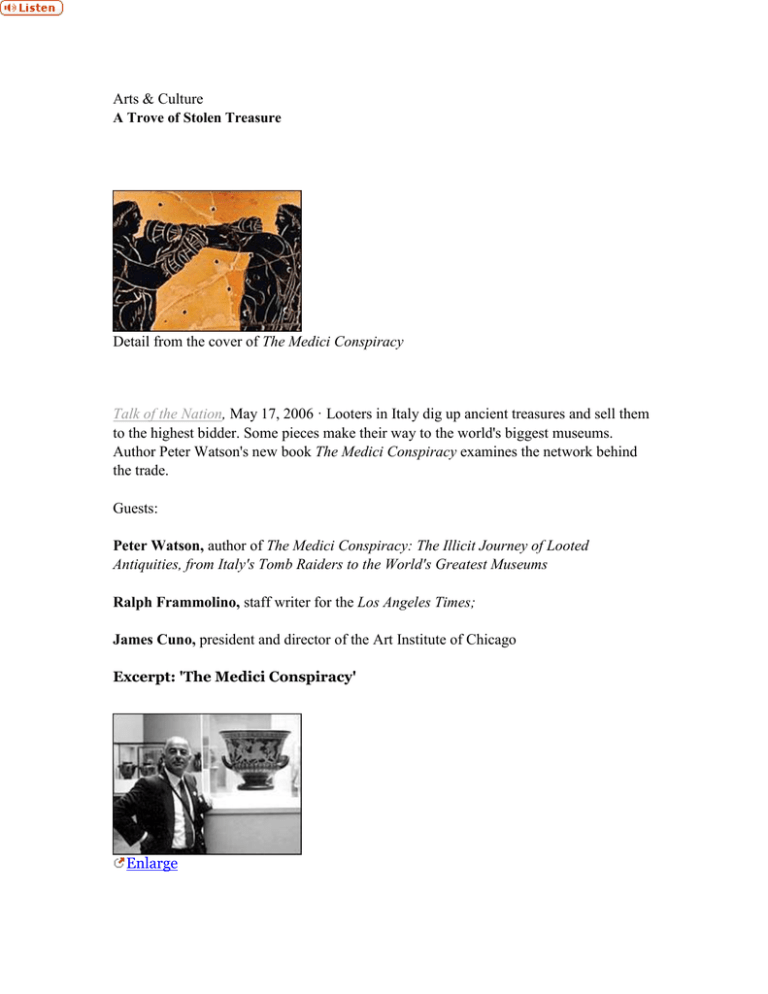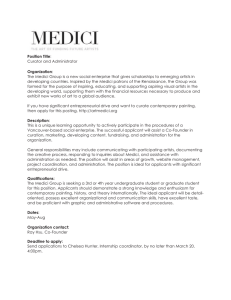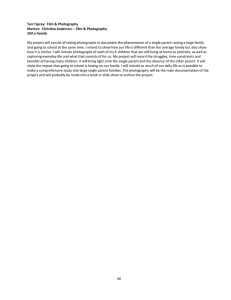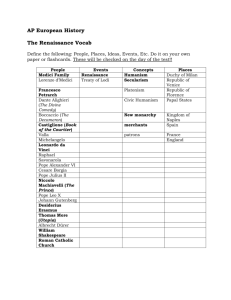
Arts & Culture
A Trove of Stolen Treasure
Detail from the cover of The Medici Conspiracy
Talk of the Nation, May 17, 2006 · Looters in Italy dig up ancient treasures and sell them
to the highest bidder. Some pieces make their way to the world's biggest museums.
Author Peter Watson's new book The Medici Conspiracy examines the network behind
the trade.
Guests:
Peter Watson, author of The Medici Conspiracy: The Illicit Journey of Looted
Antiquities, from Italy's Tomb Raiders to the World's Greatest Museums
Ralph Frammolino, staff writer for the Los Angeles Times;
James Cuno, president and director of the Art Institute of Chicago
Excerpt: 'The Medici Conspiracy'
Enlarge
Giacomo Medici, photographed alongside the Euphronios krater in the
Metropolitan Museum of Art in New York. This photograph was found during the
police raid on his warehouse in Geneva Freeport.
Enlarge
Fresco wall 7, showing the pieces cut into laptop-size fragments, reassembled and
laid out on the restorer's trestle table in Zurich, Switzerland like a large jigsaw
puzzle, prior to total restoration. The photo was found in Geneva.
Enlarge
Photograph albums, cataloging stolen items, seized from the Geneva Freeport
warehouse.
A 1995 raid on suspected tomb raider Giacomo Medici's warehouse in Geneva
showed that Medici had been storing thousands of ancient vases, frescos, and
other antiquities -- some in fragments or in various stages of restoration, some
encrusted with dirt -- out of reach of the Italian government, in the Swiss
Freeport. The Italian Carabinieri Art Squad gained access to the warehouse in
1997, as part of their investigation into Medici's ties to a global ring of looters,
dealers, curators and collectors who worked to smuggle antiquities out of Italy.
The documentation they found in Medici's warehouse proved to be as damning
as the objects themselves.
Excerpt from Chapter 6
Although the antiquities themselves formed the most vivid and moving aspect of
the seizure in Geneva, there was no less interest -- for Conforti and for Ferri -- in
the documentation found in the back office behind Medici's showroom. While the
three archaeologists concentrated on the objects, the paperwork became the
responsibility of Maurizio Pellegrini, a photographic and document expert who
had one foot in the public prosecutor's office and the other in the Villa Giulia…
The size of the task facing Pellegrini may be gauged from the fact that there were
in Medici's warehouse thirty albums of Polaroids, fifteen envelopes with
photographs, and twelve envelopes with rolls of film. Besides the albums of
photographs, Pellegrini calculated that some 100 full rolls of exposed film were
seized, making a total of 3,600 images…
The Polaroids fell into distinct groups. First, there were photographs of objects
that were encrusted with dirt or calcarious deposits, in which the antiquities were
often broken and incomplete. In other words, these objects were photographed
near where they were excavated, in nearby fields or farmyards, in the houses of
tombaroli, even on the back of a truck in one case. Next, however, there were
many Polaroids showing the same objects restored, with the fragments joined
together. In many cases, although the fragments had been joined together, the
joins of the fragments were still visible, as were the gaps (the lacunae) where
parts of the vases, say, were still missing. In due course, Pellegrini pieced
together why the objects had been photographed in this state -- but not at first.
Next came a series of photographs -- Polaroids again -- in which once more the
same objects were depicted, but this time they had been fully restored, with the
joins covered over and repainted and polished to look almost as good as new. In
some cases, as Pellegrini worked through the documents, he found that many of
these restored objects were also depicted in auction house catalogs or in museum
publications. Finally, there was a most interesting set of photographs in which
Medici, and sometimes others, were pictured alongside antiquities that were on
display in particular museums. Over the months, Pellegrini was able to sift the
photographs in such a way that, for dozens of objects, he could reconstruct an
entire sequence: from objects just out of the ground, dirty and broken, to being
restored, to being on display in the world's museums. Medici, it turned out, was a
stickler for keeping records, and it was the photographs that provided Pellegrini
with the first inkling of the totality of Medici's involvement. Many of the
photographs had writing on them that directed him elsewhere in the
documentation, and no less important, many showed interiors that he began to
recognize as the investigation proceeded. This also helped him to piece together
the complex web of interrelationships that would in time be fully exposed.
Pellegrini had to start somewhere, so he chose what was far and away the most
immediately shocking set of photographs. This was a folder with, on the outside,
the words " Pitture romana Via Bo.”….
" Mi é preso un colpo!” he breathed. " I was hit.” He couldn't believe his eyes, and
he called out to the professors.
Zevi, the first to reach him, took the camera. " He was speechless,” says
Pellegrini. " Scandalized.”
What the images revealed was a dismaying sequence -- " a real horror,” as he
wrote in his report -- in which the first pictures showed three walls of what any
expert could recognize as a Vesuvian/Pompeian villa. They could make this
identification because the three walls were frescoed in what is called the
Campanian II style. The decoration on Roman villas went through what art
historians and archaeologists recognize as four styles, between the second
century bc and ad 79. Campanian II comes second in this chronology, and
decorations in that style differ from what came before and after in consisting of
more panoramic landscapes, mythological scenes, and certain architectural
features.
The photographs showed nine walls in all, but three were of particular interest.
Two of them were in red, pale blue, and gray. These walls showed two female
figures in the foreground with, below them, miniaturized masks and smaller
figures. On the right wall was shown an architectural drawing of a two-story
building, with a similar symmetric design opposite, on the left wall. In other
words, in this first sequence of photographs, the room -- or one end of it -- is
intact. " The frescoes are in an excellent state of conservation, both pictorially and
structurally.” However, besides the walls of the room, the photographs also
showed a mass of earth mixed with lapillae covering the floor and filling the space
to a depth of a few feet; lapillae also encrust the ceiling area. Lapillae are a telltale
sign to any Italian archaeologist. They are small balls of volcanic ash, formed
after the eruption of Vesuvius in ad 79, which buried so much of the surrounding
countryside south of Naples. This was further confirmation, in addition to the
subject matter and pictorial style of the frescoes, that this room had been part of
a villa that was one of those overwhelmed by the eruption of the famous volcano,
but not one known to the official archaeologists. The first sequence of
photographs therefore confirmed that this had been a very important discovery,
made in a clandestine " excavation” by some tombaroli. It was the next set of
photographs, however, that constituted the " horror.”
This second set showed the image of the central wall -- the one with the two
female figures and the figurines -- but laid out like a giant jigsaw. The images had
been cut from the original wall, in a number of highly irregular pieces, each in
size about as big as a laptop, and then put back together again on panels that
were framed -- edged -- in wood. The fresco had been taken off the villa wall,
detached from its right and left companions, and cut up into chunks. That it was
the same image was quite clear to Pellegrini, even though there were gaps
between the separate pieces: The two females were clearly visible and
recognizable. In his report, Pellegrini commented that this operation, normally
highly technical (when done by archaeologists), was here done crudely and in a
hurry, without any regard for the integrity or sanctity of the images but simply so
that the fresco could be quickly and more easily smuggled abroad…
This, then, was the distressing starting point for Pellegrini. It revealed the scale of
the traffic in illegally excavated antiquities, and the brutality shown by the
tombaroli and those above them in respect to important and beautiful ancient
objects, as well as the utter indifference to the archaeological importance of
Italy's heritage, and it showed how inappropriate the word " excavation” is when
applied to these activities.
"From the book The Medici Conspiracy: The Illicit Journey of Looted Antiquities
from Italy’s Tomb Raiders to the World’s Greatest Museums by Peter Watson
and Cecilia Todeschini. Copyright 2006. Reprinted with permission from
PublicAffairs, a member of the Perseus Books Group. All rights reserved.”





